“Tales of Perrault”
Ural Opera Ballet
Ekaterinburg State Academic Opera and Ballet Theatre
Ekaterinburg, Russia
April/September 2024 (video)
by Ilona Landgraf
Copyright © 2024 by Ilona Landgraf
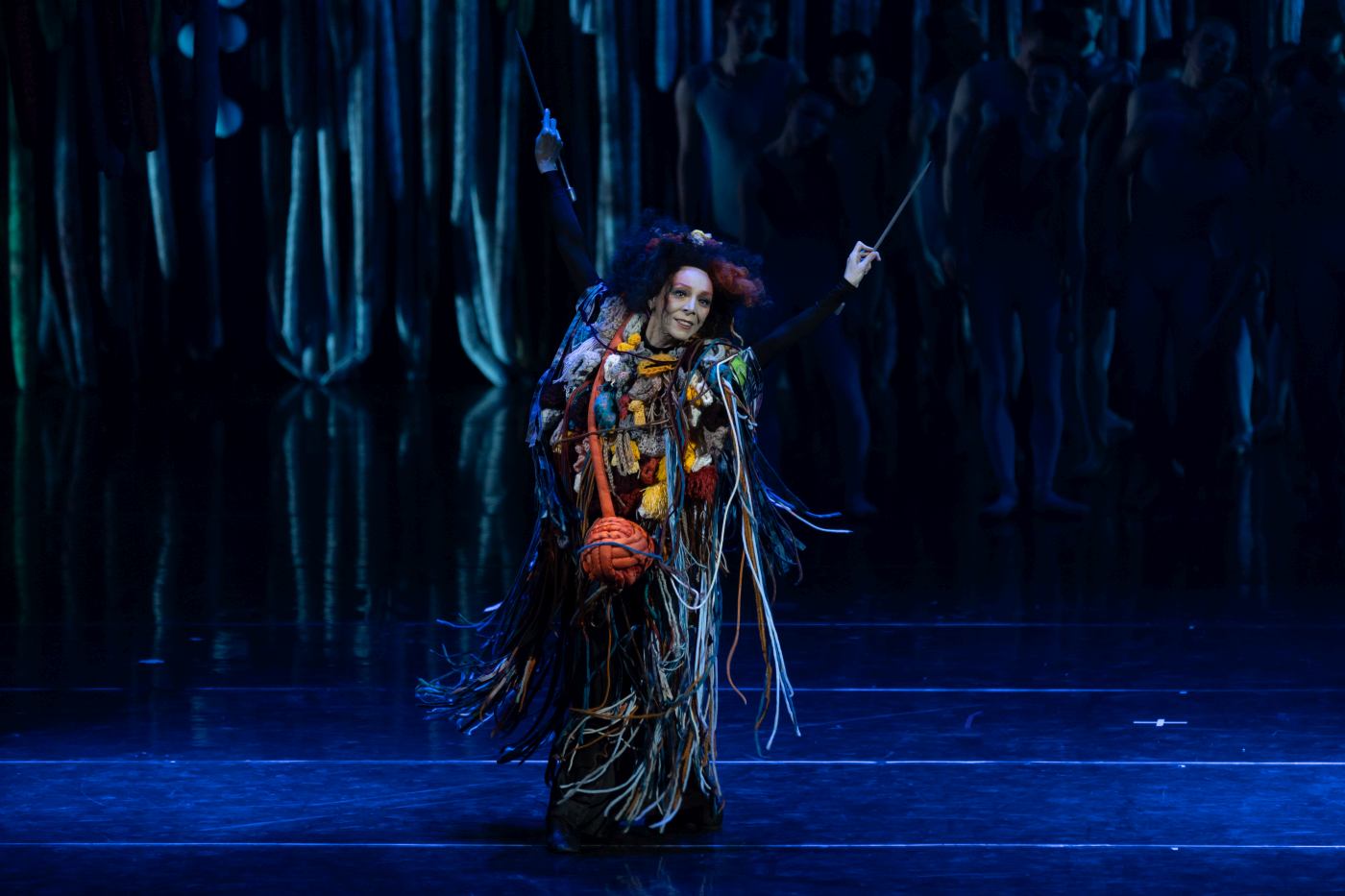 Last week, the Ural Opera Ballet’s joint production, Tales of Perrault, returned to the stage. It combines four fairy tales by Perrault—Puss in Boots, Little Red Riding Hood, Bluebeard, and Little Thumb—that are newly interpreted by three choreographers. Two of them, Konstantin Khlebnikov and Alexandr Merkushev, are junior choreographers from the company’s ranks of dancers; the third, Maksim Petrov, choreographed for the Mariinsky Ballet before succeeding the Ural Opera Ballet’s then-artistic director, Vyacheslav Samodurov, in August 2023.
Last week, the Ural Opera Ballet’s joint production, Tales of Perrault, returned to the stage. It combines four fairy tales by Perrault—Puss in Boots, Little Red Riding Hood, Bluebeard, and Little Thumb—that are newly interpreted by three choreographers. Two of them, Konstantin Khlebnikov and Alexandr Merkushev, are junior choreographers from the company’s ranks of dancers; the third, Maksim Petrov, choreographed for the Mariinsky Ballet before succeeding the Ural Opera Ballet’s then-artistic director, Vyacheslav Samodurov, in August 2023.
Perrault’s fairy tales are often dark and scary (which is why Tales of Perrault is reserved for an adult audience and children aged twelve and older) but with a poetic note. From their wide range of meanings, the choreographers distilled a core message that combines all four fairy tales: regardless of one’s physicality, conduct, and wit, everyone deserves love and sympathy.

 On stage, the Mushroom Fairy (Nadezhda Shamshurina) embodied a reliable source of love and kindness. A senior lady with a penchant for knitting, she produced with her tireless needles the mystical forest in which the fairy tales played. The forest’s rampant growth also extended onto the garb of some players, which appeared to be covered by colorful patches of moss or fringe-like lianas (set and costumes by Yuliana Laikova). The Mushroom Fairy’s four-man entourage of hunters roamed the knitted biotope, vigorously pushing neon-rimmed, snail-like creatures like vacuum cleaners. Every instruction from their boss’s needles swung the hunters into action. They pulled a corps of not yet configured fairy tale figures out of the thicket, and shaped them as ordered before clearing the stage for Puss in Boots (Tomokha Terada) and the miller’s son (Andrey Veshkurtsev).
On stage, the Mushroom Fairy (Nadezhda Shamshurina) embodied a reliable source of love and kindness. A senior lady with a penchant for knitting, she produced with her tireless needles the mystical forest in which the fairy tales played. The forest’s rampant growth also extended onto the garb of some players, which appeared to be covered by colorful patches of moss or fringe-like lianas (set and costumes by Yuliana Laikova). The Mushroom Fairy’s four-man entourage of hunters roamed the knitted biotope, vigorously pushing neon-rimmed, snail-like creatures like vacuum cleaners. Every instruction from their boss’s needles swung the hunters into action. They pulled a corps of not yet configured fairy tale figures out of the thicket, and shaped them as ordered before clearing the stage for Puss in Boots (Tomokha Terada) and the miller’s son (Andrey Veshkurtsev).

 Their adventures were choreographed by Khlebnikov. He turned Puss in Boots into a brisk satire that was at times cliché but often refreshingly humorous. The miller’s son loved to horse around but wasn’t the sharpest knife in the drawer. Due to his cunning tomcat buddy, he seemed to have a skyrocketing career but remained the same simple guy under his noble garb. While the slinky cat put on a show for the King and his daughter (Ekaterina Kuznetsova), the future miller-cum-Marquis hid among red lianas that grew from above like mincemeat from a grinder (perhaps an allusion to Puss in Boot’s threats that “you shall be chopped up like mincemeat” launched at the countrymen in the fairy tale?).
Their adventures were choreographed by Khlebnikov. He turned Puss in Boots into a brisk satire that was at times cliché but often refreshingly humorous. The miller’s son loved to horse around but wasn’t the sharpest knife in the drawer. Due to his cunning tomcat buddy, he seemed to have a skyrocketing career but remained the same simple guy under his noble garb. While the slinky cat put on a show for the King and his daughter (Ekaterina Kuznetsova), the future miller-cum-Marquis hid among red lianas that grew from above like mincemeat from a grinder (perhaps an allusion to Puss in Boot’s threats that “you shall be chopped up like mincemeat” launched at the countrymen in the fairy tale?).
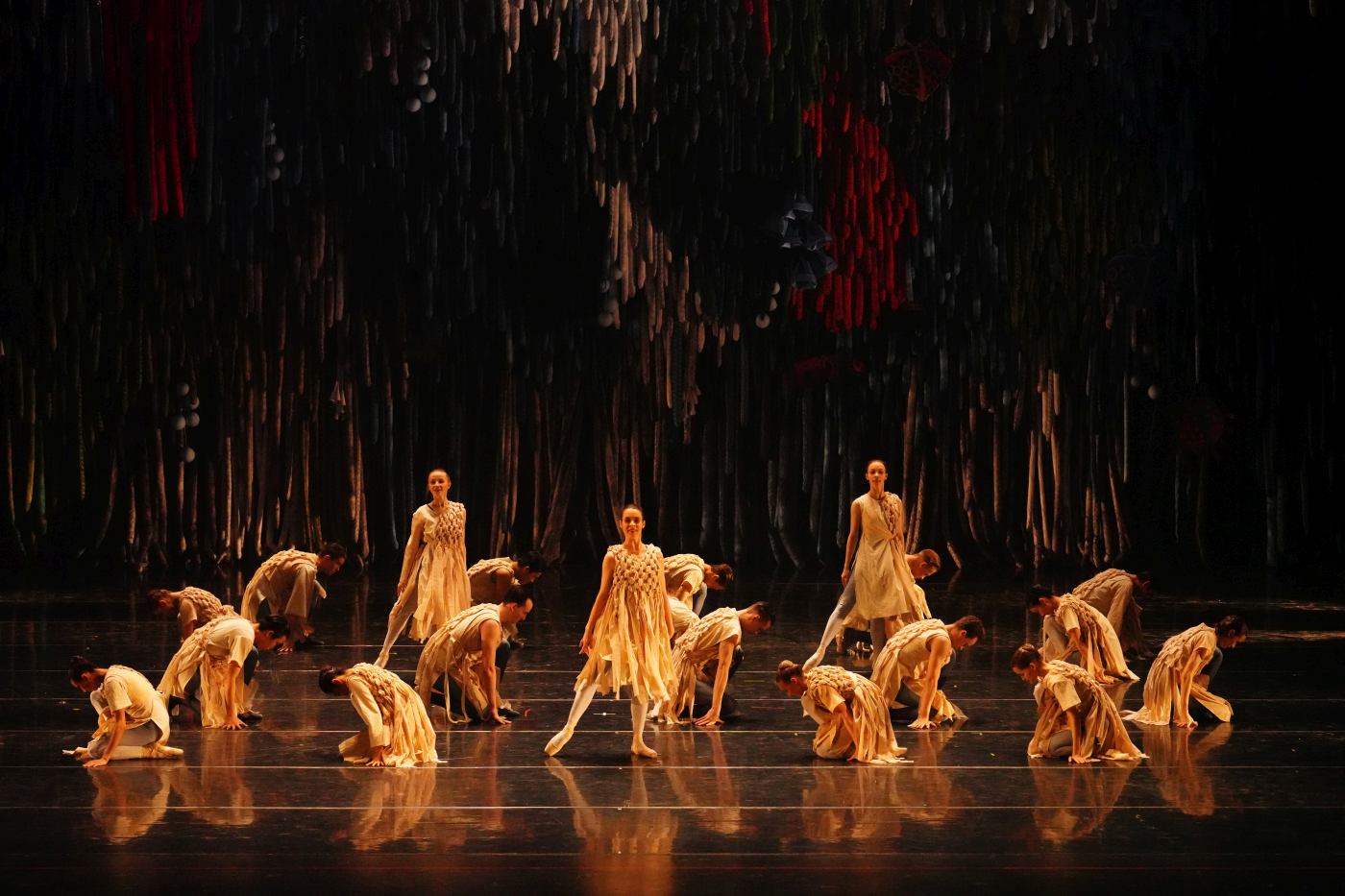
 The miller’s son slumped out of his hideout, and then his dashing, toreador-like stunt won the heart of the princess right away. While he waltzed off with the royals, their household secretly teamed up with the cat. Newly ennobled as Marquis, the miller’ son fancied himself a terrific guy who hit the jackpot. After fighting a boxing-ring-like duel for the crown with an ogre and some scheming courtiers, all ended well indeed (thanks to the intervention of the Mushroom Fairy). Cat’s clutches lurking in the thicket caught the ogre, the crown returned to the King’s head, and Puss in Boots was celebrated as the actual hero.
The miller’s son slumped out of his hideout, and then his dashing, toreador-like stunt won the heart of the princess right away. While he waltzed off with the royals, their household secretly teamed up with the cat. Newly ennobled as Marquis, the miller’ son fancied himself a terrific guy who hit the jackpot. After fighting a boxing-ring-like duel for the crown with an ogre and some scheming courtiers, all ended well indeed (thanks to the intervention of the Mushroom Fairy). Cat’s clutches lurking in the thicket caught the ogre, the crown returned to the King’s head, and Puss in Boots was celebrated as the actual hero.
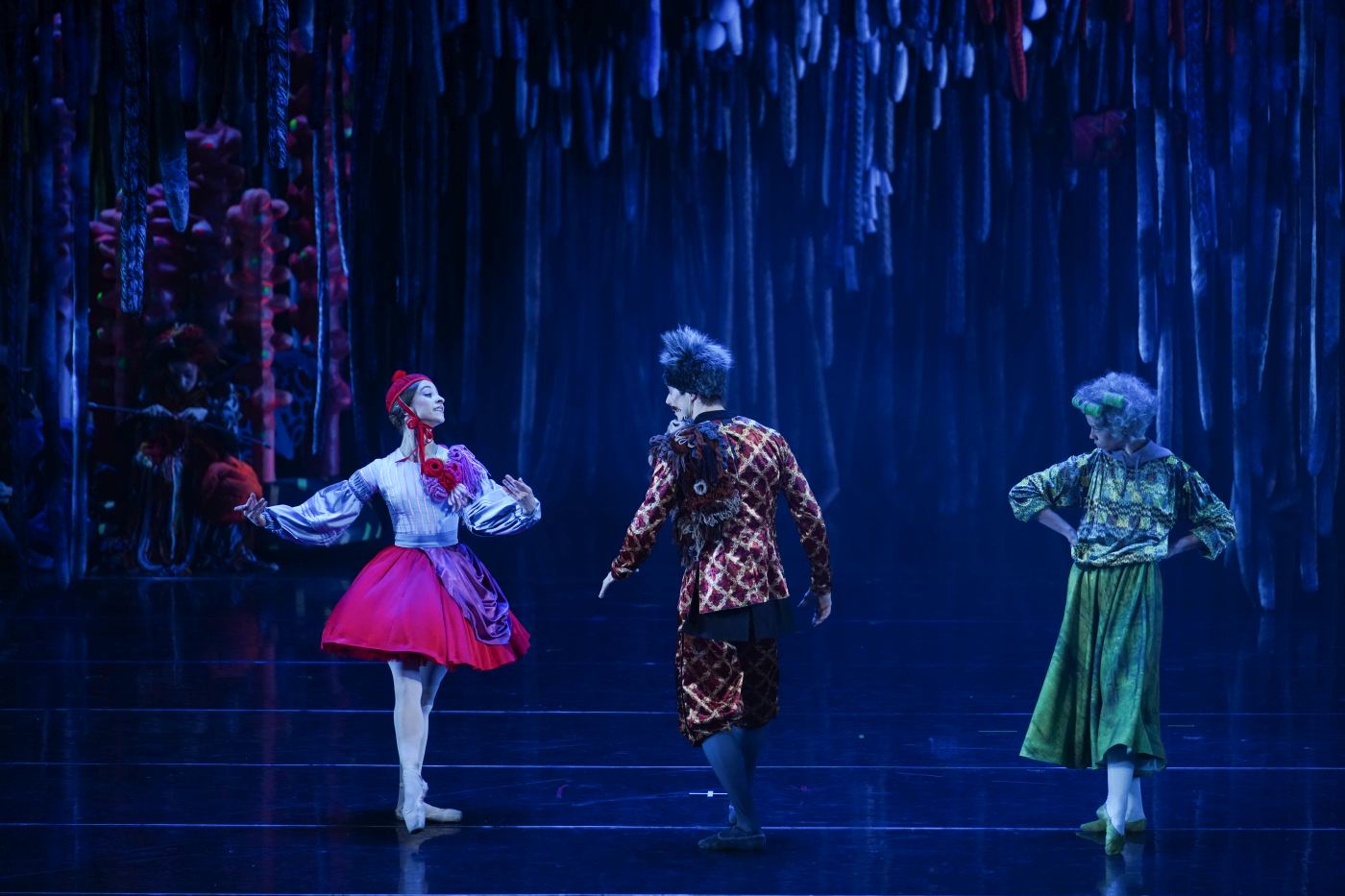
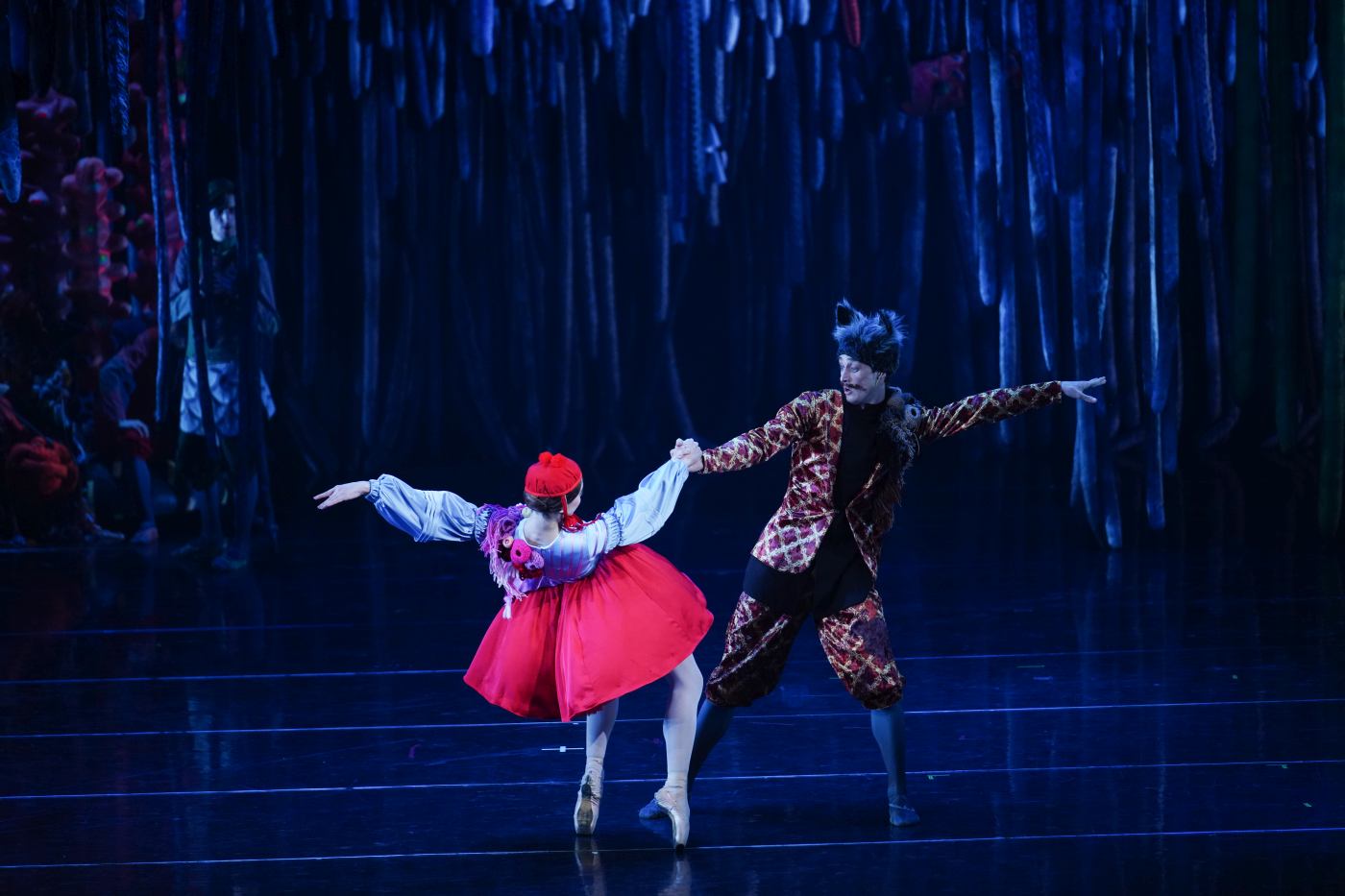 The part of Red Riding Hood (choreographed by Merkushev) was the shortest and, because of its unorthodox interpretation, the most interesting. Neither ill nor bedbound, the grandmother (Inna Avdeeva) resembled a spry old campaigner who fought the Mushroom Fairy’s men and determinedly interfered when she observed the blossoming romance between Red Riding Hood (Mariya Mikheeva) and the wolf (Ivan Sidelnikov).
The part of Red Riding Hood (choreographed by Merkushev) was the shortest and, because of its unorthodox interpretation, the most interesting. Neither ill nor bedbound, the grandmother (Inna Avdeeva) resembled a spry old campaigner who fought the Mushroom Fairy’s men and determinedly interfered when she observed the blossoming romance between Red Riding Hood (Mariya Mikheeva) and the wolf (Ivan Sidelnikov).
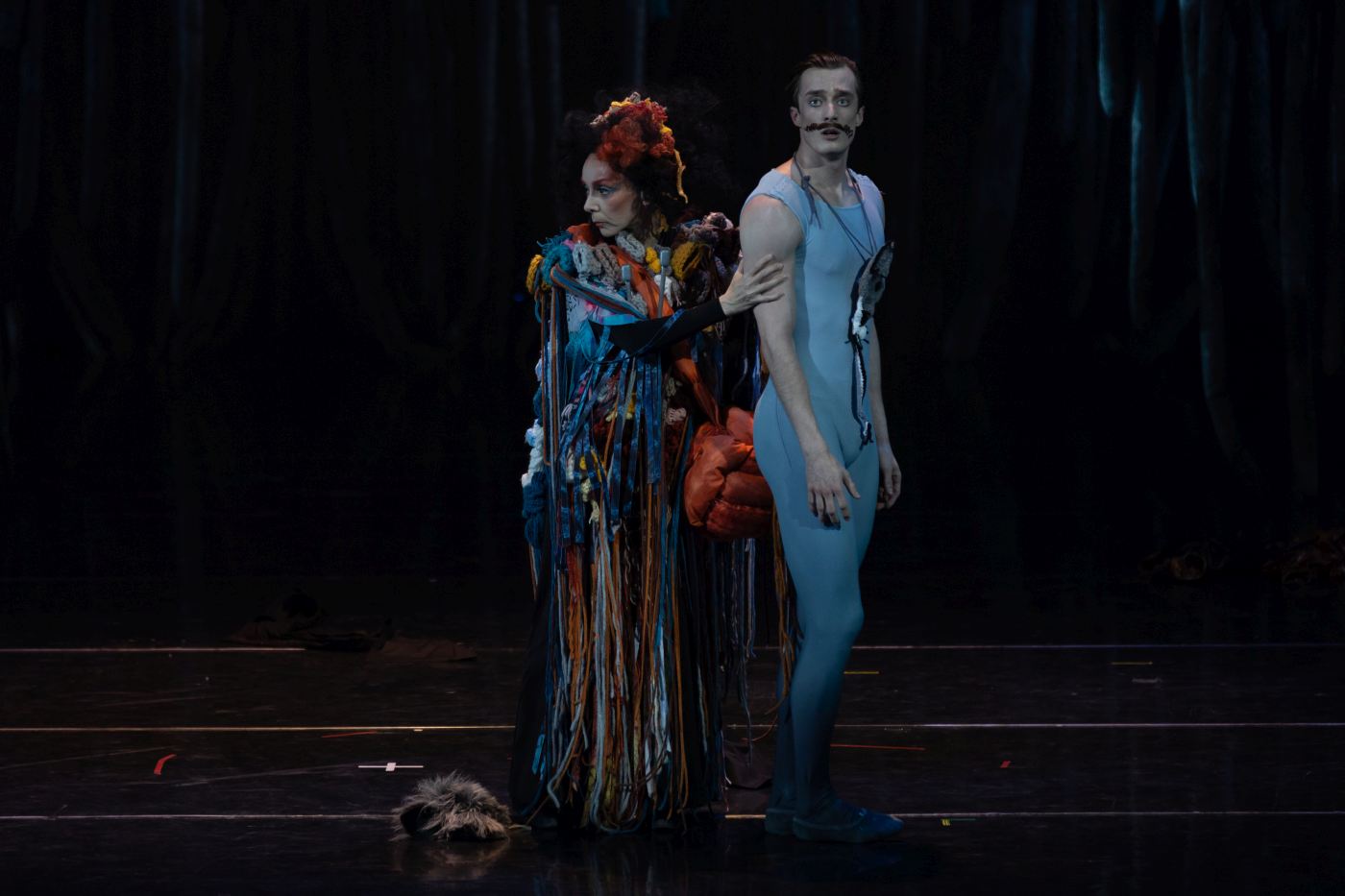
 As if to unmask a fraudster, she ripped off the wolf’s clothes, but, once skinned, the wolf collapsed like a defenseless child. Surprised and a bit startled, the grandmother and Red Riding Hood watched as the Mushroom Fairy took care of him.
As if to unmask a fraudster, she ripped off the wolf’s clothes, but, once skinned, the wolf collapsed like a defenseless child. Surprised and a bit startled, the grandmother and Red Riding Hood watched as the Mushroom Fairy took care of him.
Petrov and Merkushev choreographed the creepy Bluebeard. Its hero was pulled onto the eerily blue-lit stage and entangled in a knitted webwork as heavy as lead. Though aged and weighed down by inner struggle, he was a fighter by nature. His hand trembled, and his gait was heavy after he freed himself from the hunter’s encirclement. But his figure still incited shrieks from the seven women who dared to approach him (or arose from his hallucination).

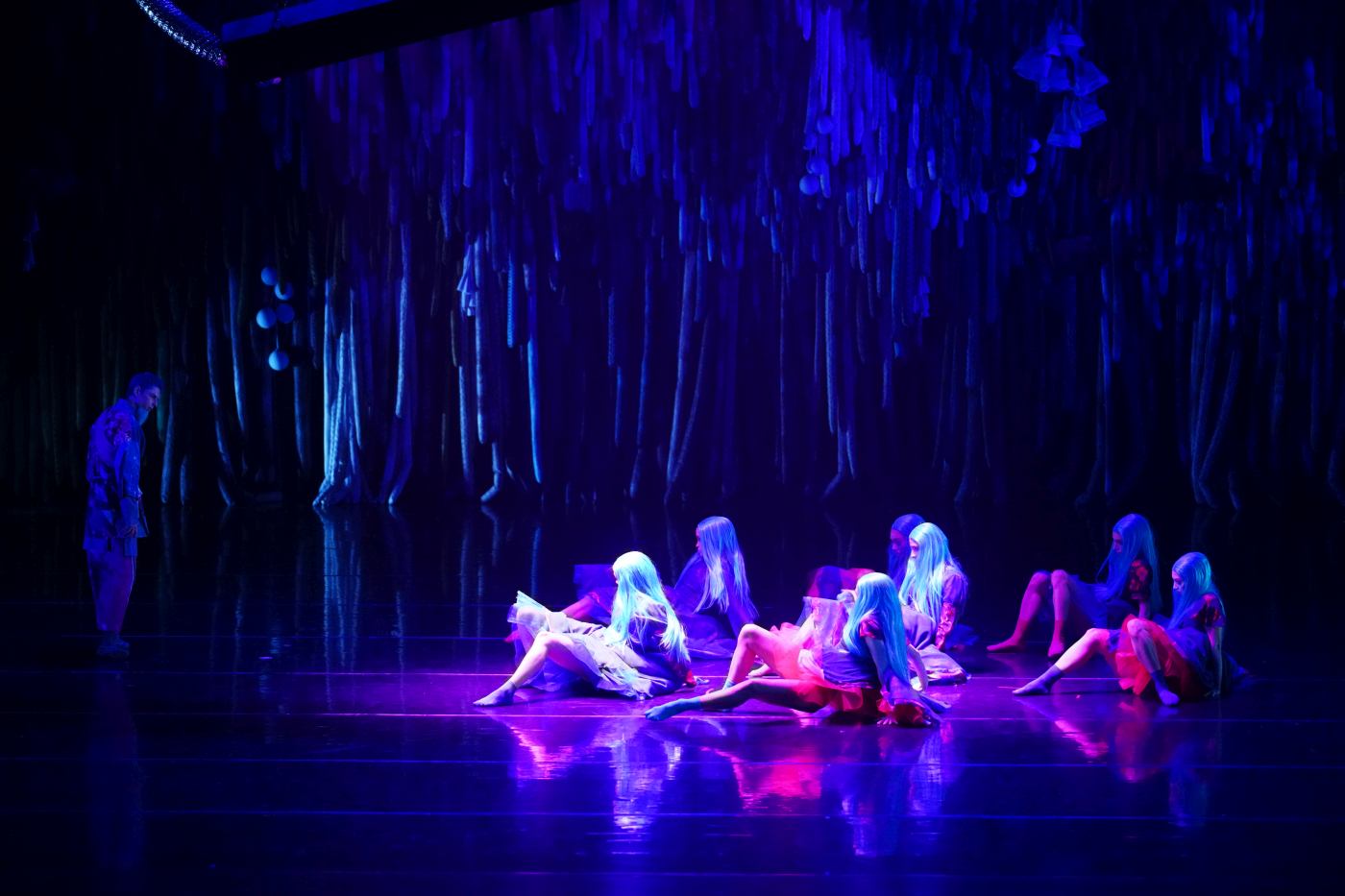 Uniformly long-haired and identically dressed, they moved toward him like swashing waves, and it wasn’t clear if they believed they were bringing him to his senses or if they were witches who wanted to be murdered. The light bar that hovered above Bluebeard like iron ready to hammer bathed the action in pink fluorescent light. The light became red the moment the bloodbath took place. Once cleared of corpses, the stage was ready for woman number eight (Ekaterina Kuznetsova) to fling herself at Bluebeard. He rebuffed her harshly (which seemed to be his general approach to life), but nevertheless gave her the key, which—like in the fairy tale—she used despite his ban. A brief blackout temporarily prevented the audience from knowing if she was strangled by Bluebeard’s embrace, but, no, seconds later she was still alive, stroking his hair despite his resistance.
Uniformly long-haired and identically dressed, they moved toward him like swashing waves, and it wasn’t clear if they believed they were bringing him to his senses or if they were witches who wanted to be murdered. The light bar that hovered above Bluebeard like iron ready to hammer bathed the action in pink fluorescent light. The light became red the moment the bloodbath took place. Once cleared of corpses, the stage was ready for woman number eight (Ekaterina Kuznetsova) to fling herself at Bluebeard. He rebuffed her harshly (which seemed to be his general approach to life), but nevertheless gave her the key, which—like in the fairy tale—she used despite his ban. A brief blackout temporarily prevented the audience from knowing if she was strangled by Bluebeard’s embrace, but, no, seconds later she was still alive, stroking his hair despite his resistance.
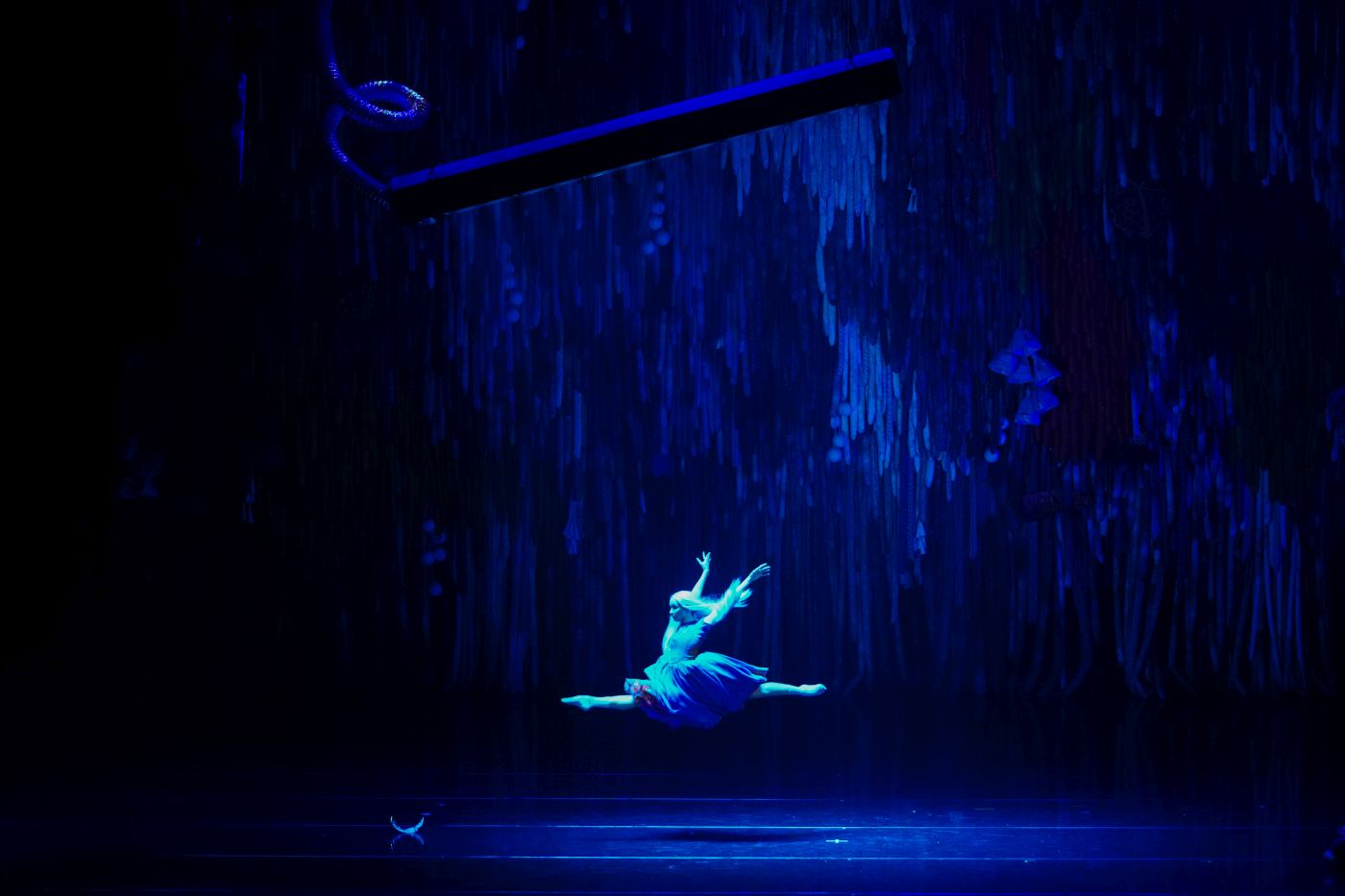
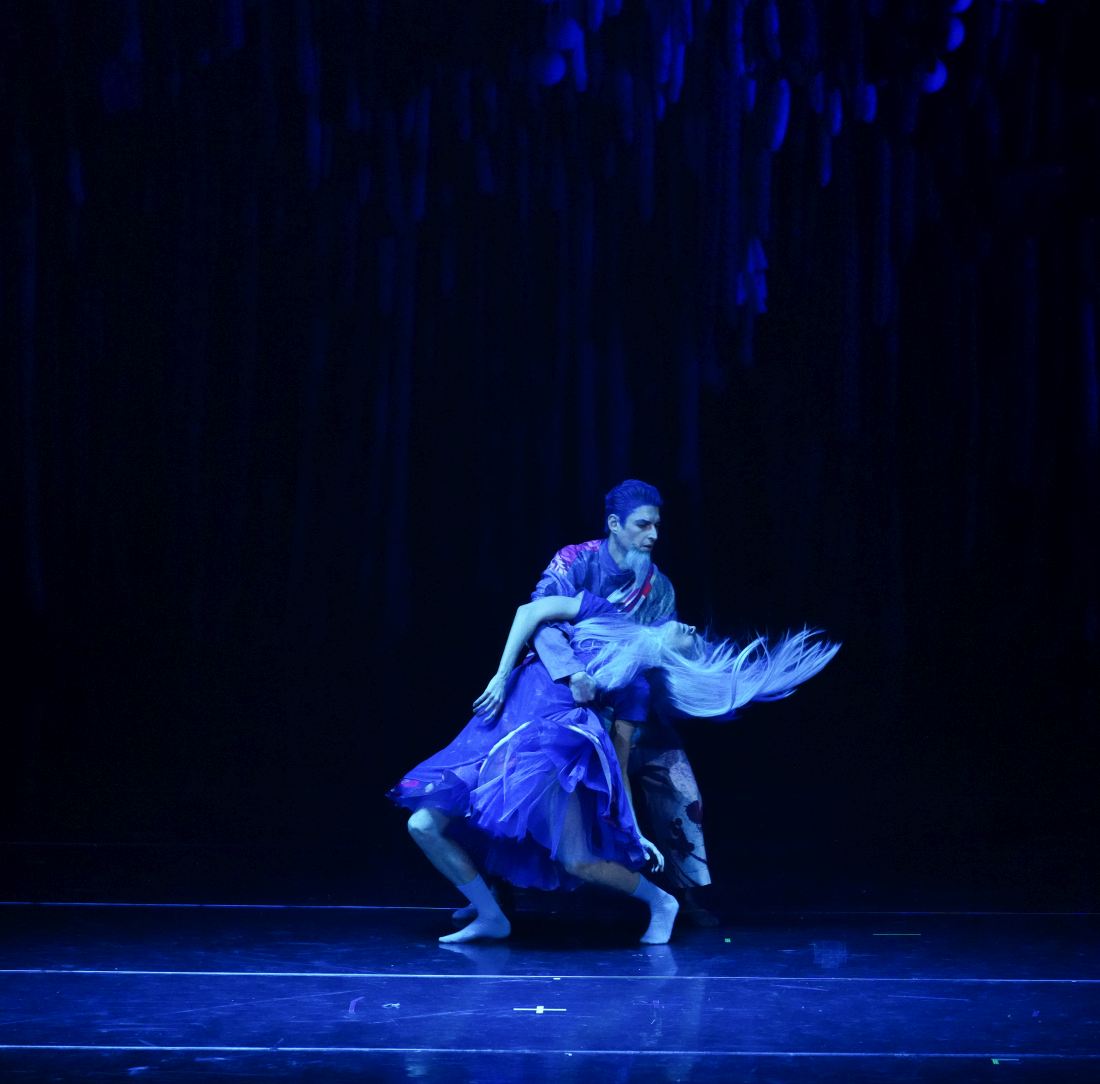 Wavering between responsiveness and aggression, Bluebeard succumbed when the other seven women supported the new one. Similar to the Chosen One in Nijinsky’s The Rite of Spring, she performed some final jumps before collapsing amid the circle of bystanders and being carried away like a martyr on the cross.
Wavering between responsiveness and aggression, Bluebeard succumbed when the other seven women supported the new one. Similar to the Chosen One in Nijinsky’s The Rite of Spring, she performed some final jumps before collapsing amid the circle of bystanders and being carried away like a martyr on the cross.
Other couples copied the dysfunctional relationship of Bluebeard and the women as if the struggle between female affection and male resistance was inalterable. A female corps manifested the archetype of a woman’s life: being attractive, cradling a baby, being obedient, and having the strength to endure.
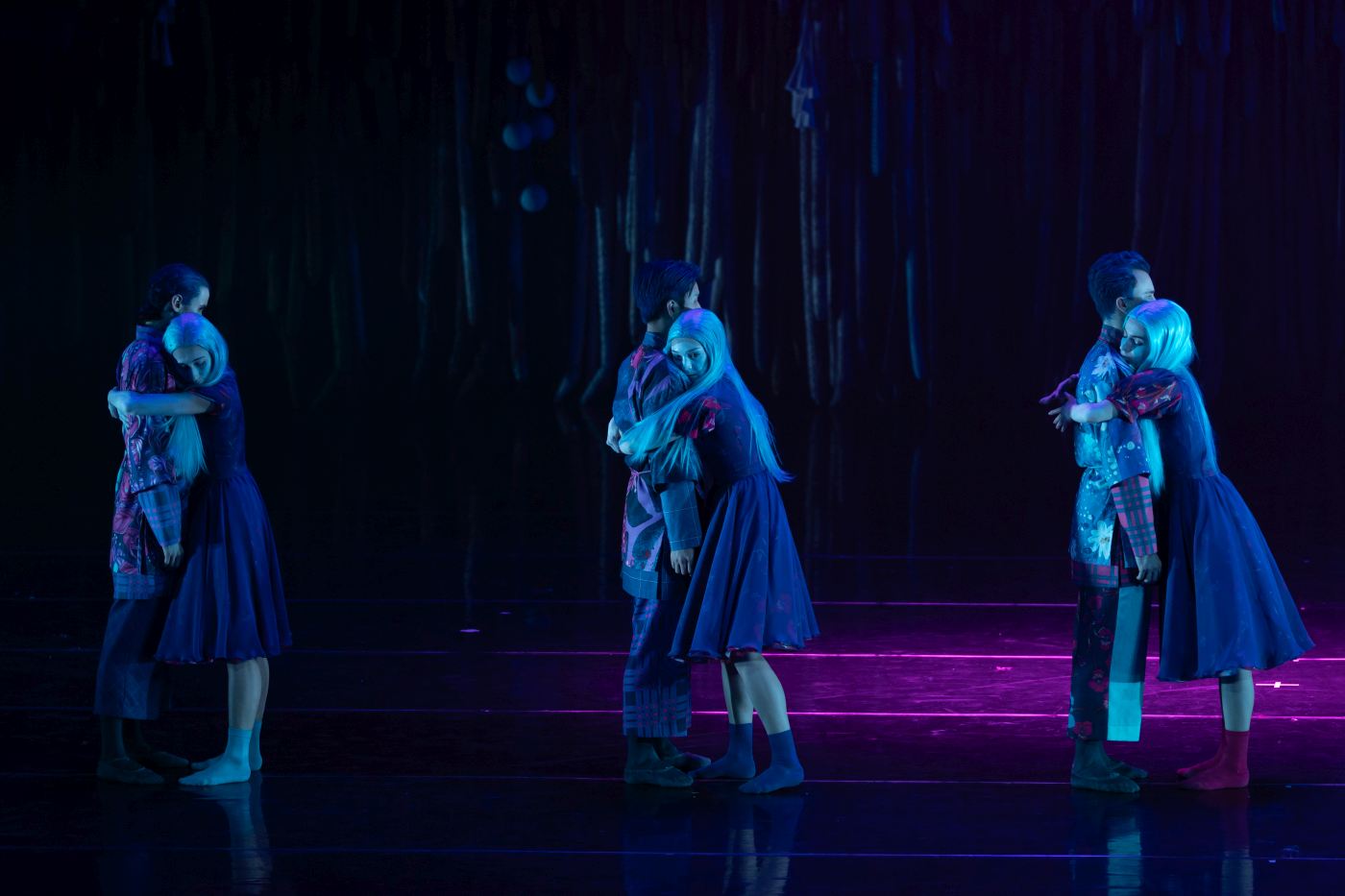
 Eventually, Bluebeard stood in the darkness of what resembled a black-and-white movie, fending off the women who ran toward him. Only the last woman stayed with him and coiled up in the Mushroom Fairy’s huge ball of wool together with him.
Eventually, Bluebeard stood in the darkness of what resembled a black-and-white movie, fending off the women who ran toward him. Only the last woman stayed with him and coiled up in the Mushroom Fairy’s huge ball of wool together with him.
Tomokha Terada’s Little Thumb (for whom Petrov choreographed) was shorter than the leather tramping boots that stood behind him. And though he was a sprightly character, the owner of the feet inside the boots ignored him for quite some time. The boot wearer’s hands were lowered to pick up the midget, but that seemed beneath the little hero’s dignity.
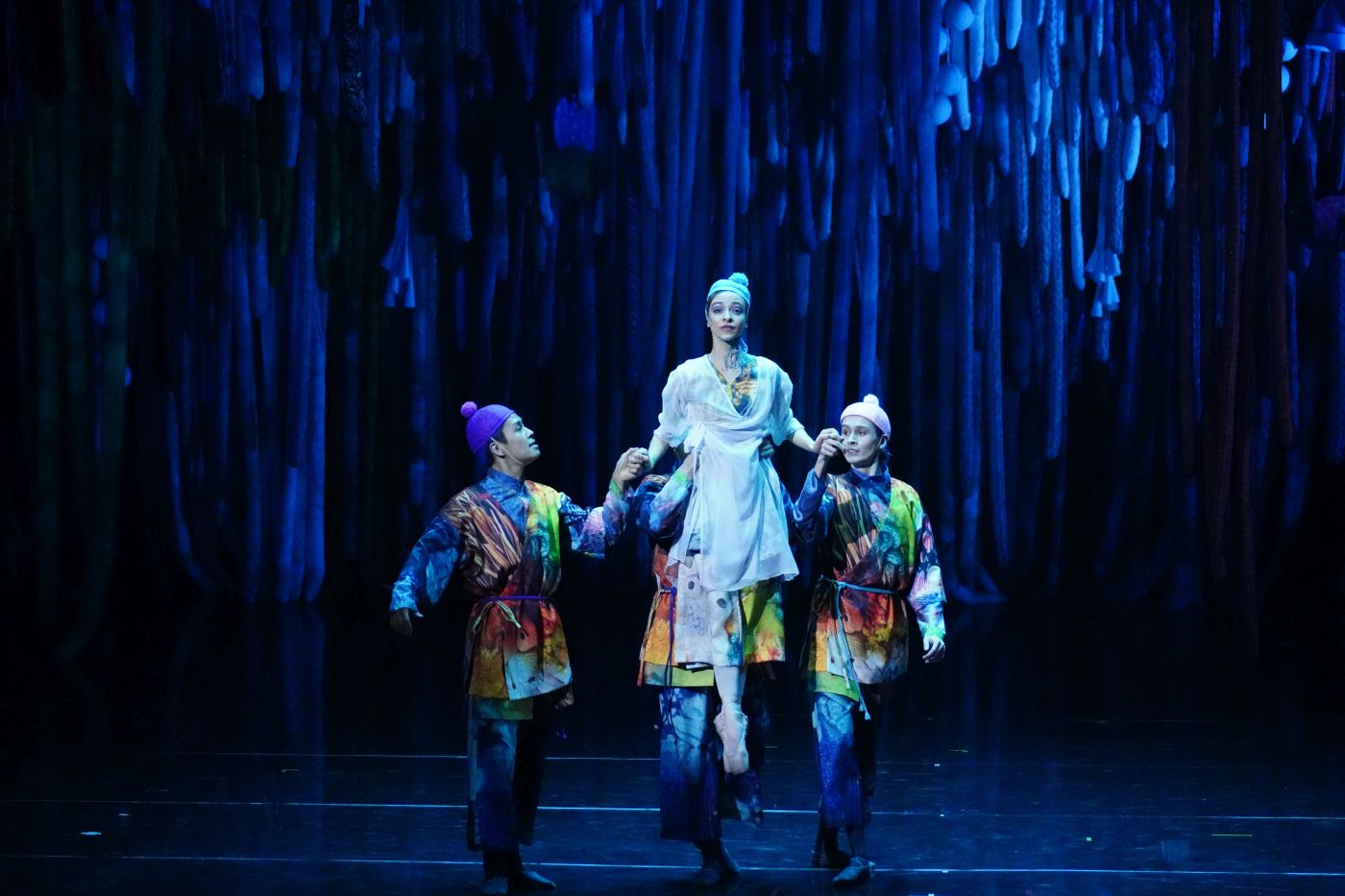
 Little Thumb’s resistance was answered with a gentle kick that carried him into the midst of horned warriors (from which the Mushroom Fairy saved him) and then three brothers in arms and the cute Thumbelina (Mariya Mikheeva). Some grisly brutes and the ogre from Puss in Boots attacked Little Thumb, but the Mushroom Fairy intervened again. Pointing at the lovestruck Little Thumb and Thumbelina, she shook her head, which brought the rueful ogre to his knees. Dark forces couldn’t harm the bastion of fairy tale heroes anymore.
Little Thumb’s resistance was answered with a gentle kick that carried him into the midst of horned warriors (from which the Mushroom Fairy saved him) and then three brothers in arms and the cute Thumbelina (Mariya Mikheeva). Some grisly brutes and the ogre from Puss in Boots attacked Little Thumb, but the Mushroom Fairy intervened again. Pointing at the lovestruck Little Thumb and Thumbelina, she shook her head, which brought the rueful ogre to his knees. Dark forces couldn’t harm the bastion of fairy tale heroes anymore.
Together with her aides, the Mushroom Fairy re-established order and calm, bidding farewell to some while pushing others off stage. She seemed exhausted but, knitting needles at the ready, quickly resumed her composure.
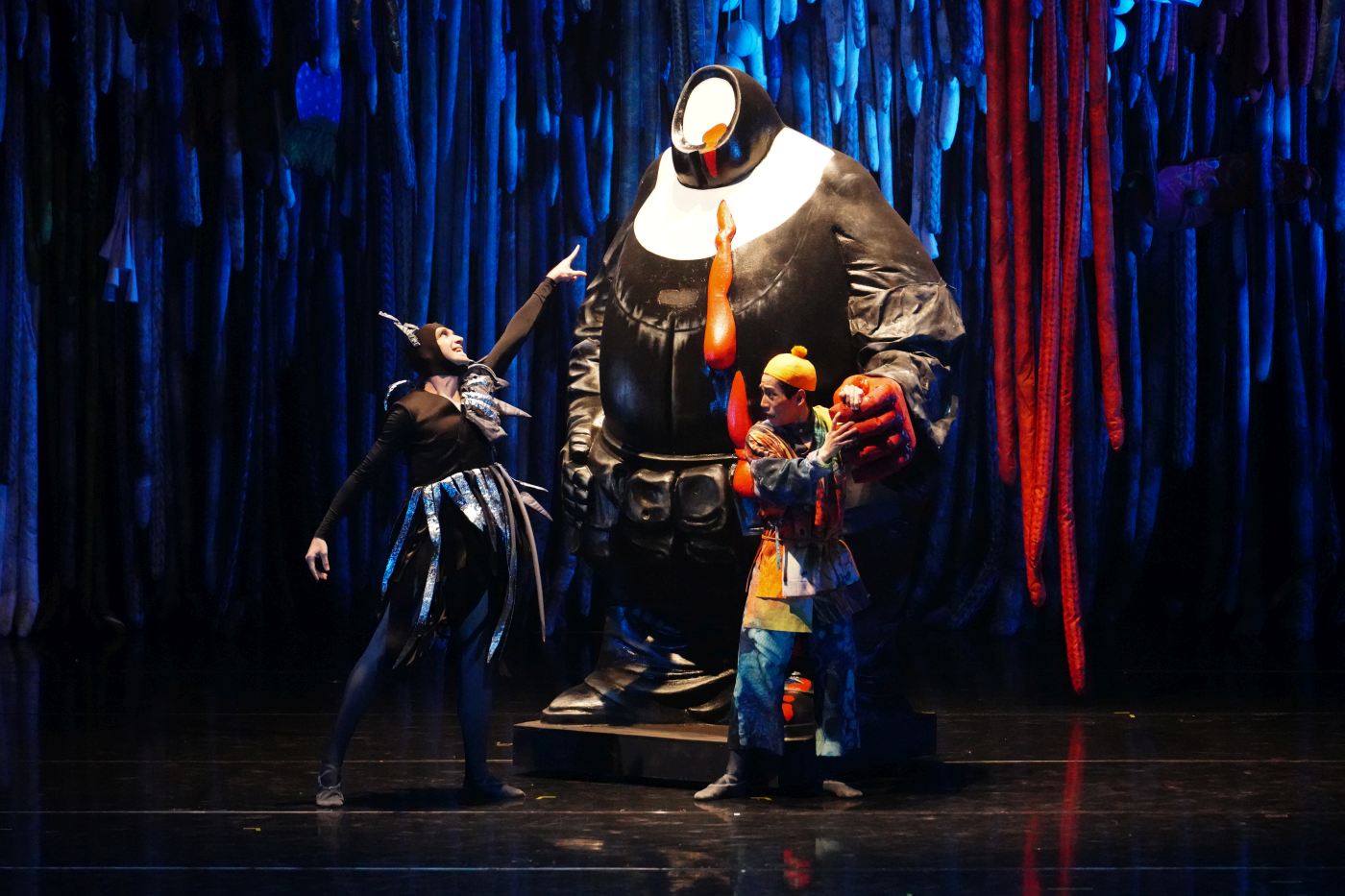
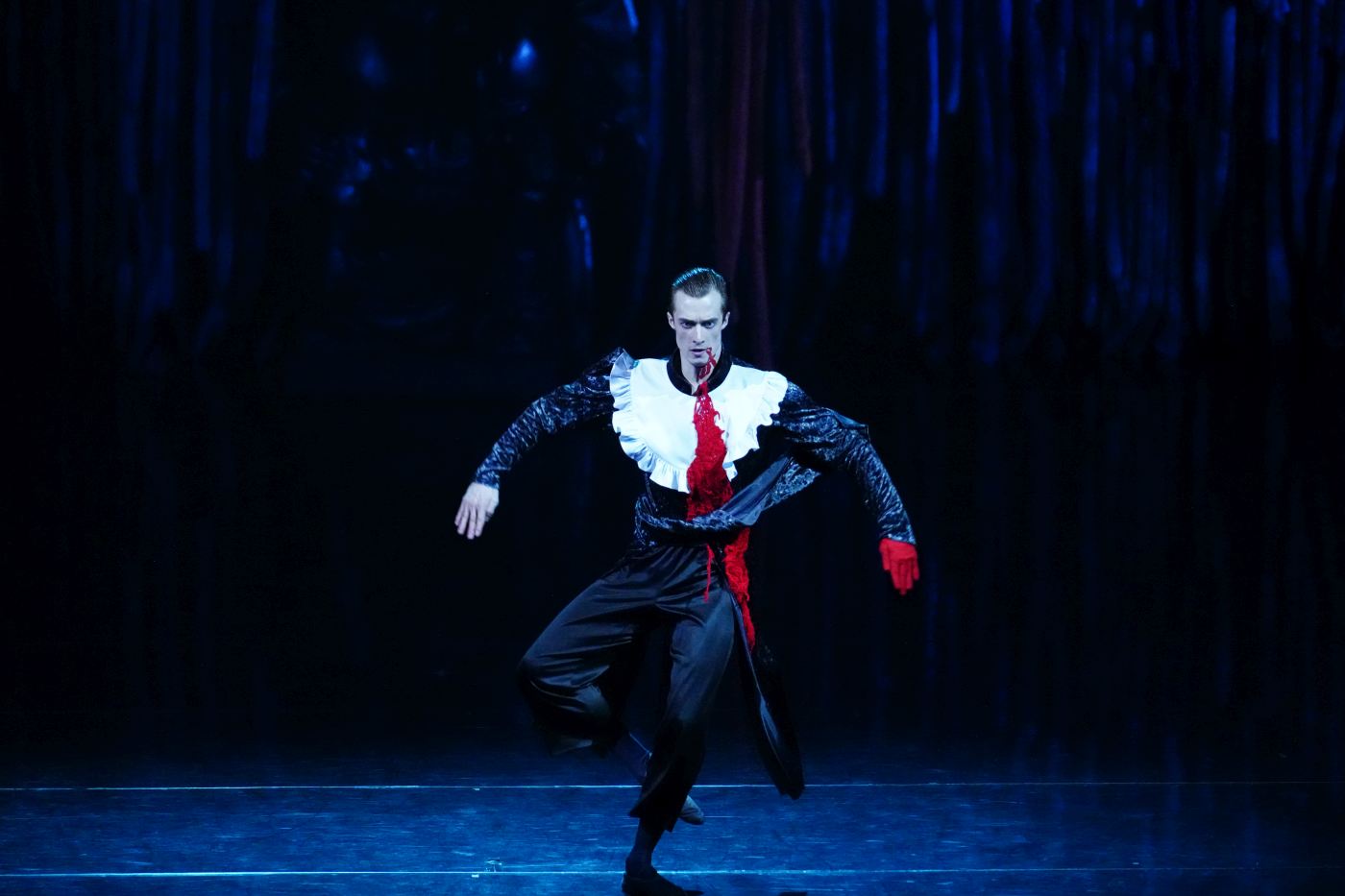 Similar to the choreography, the music was assembled from three composers: St. Petersburg-based Nastasya Khrushcheva contributed the music for Little Thumb and Red Riding Hood, Alexey Bolovlenkov (who will graduate from the St. Petersburg Conservatory later this year) composed the music for Puss in Boots, and Bluebeard was accompanied by music by Dmitry Mazurov. Perhaps because of its origin from different pens, the score was fabulously colorful and atmospheric. The violins seemed to lie in wait like tense spiders in a net. Courtly sounds and singing gave the jumbled royals in Puss in Boots a veneer of decency. Mock chamber music introduced Red Riding Hood. Some beats in Bluebeard sounded like Stravinsky’s Le Sacre. The Orchestra of the Ekaterinburg State Theatre was conducted by the Bolshoi Theatre’s renowned Pavel Klinichev.
Similar to the choreography, the music was assembled from three composers: St. Petersburg-based Nastasya Khrushcheva contributed the music for Little Thumb and Red Riding Hood, Alexey Bolovlenkov (who will graduate from the St. Petersburg Conservatory later this year) composed the music for Puss in Boots, and Bluebeard was accompanied by music by Dmitry Mazurov. Perhaps because of its origin from different pens, the score was fabulously colorful and atmospheric. The violins seemed to lie in wait like tense spiders in a net. Courtly sounds and singing gave the jumbled royals in Puss in Boots a veneer of decency. Mock chamber music introduced Red Riding Hood. Some beats in Bluebeard sounded like Stravinsky’s Le Sacre. The Orchestra of the Ekaterinburg State Theatre was conducted by the Bolshoi Theatre’s renowned Pavel Klinichev.
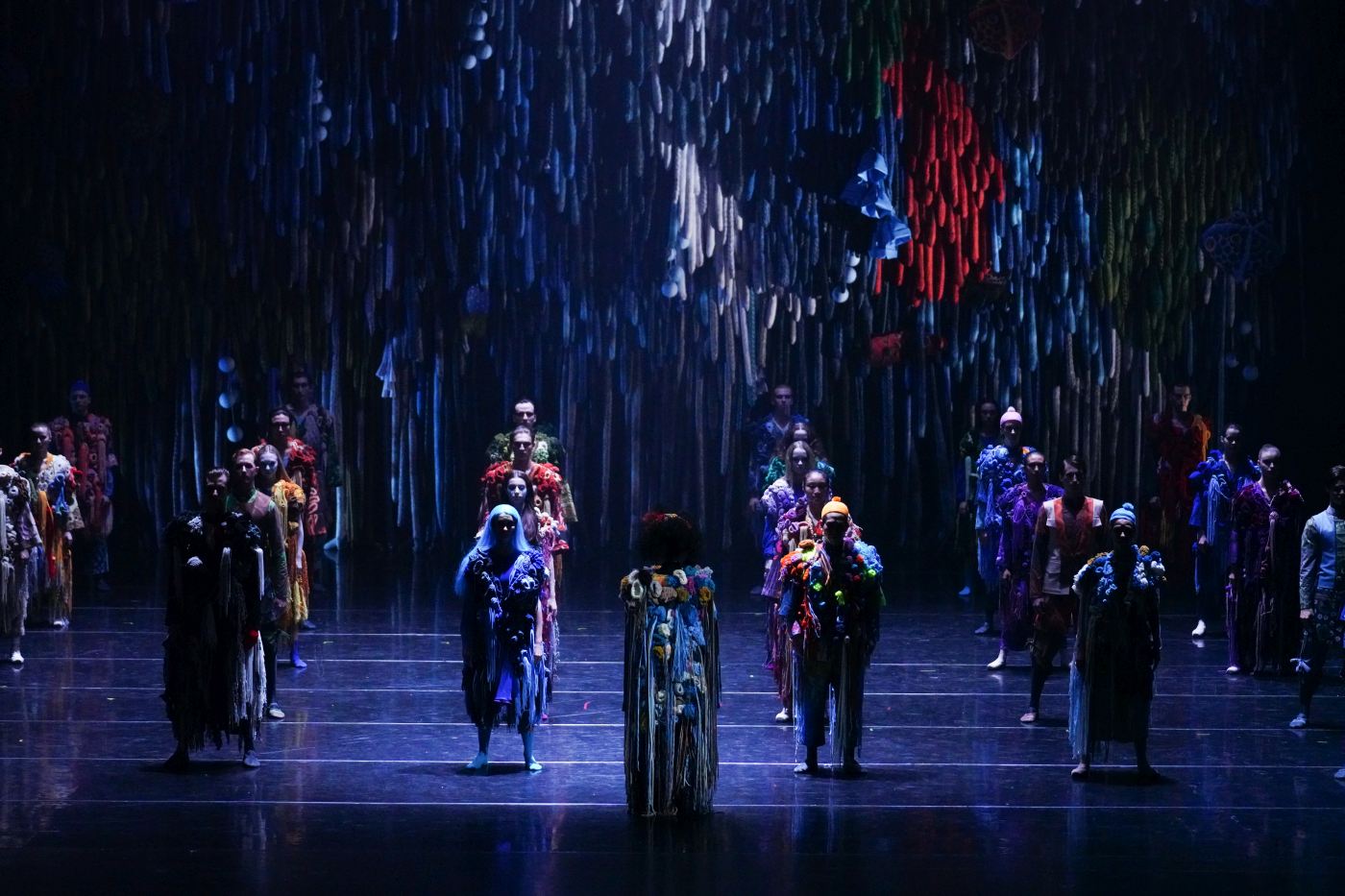
| Links: | Website of the Ural Opera Ballet | |
| “Tales of Perrault”, Rossiya Kultura | ||
| Rethinking Parrault’s Tales | ||
| Photos: | (The photos show casts of different performances.) | |
| 1. | Nadezhda Shamshurina (Mushroom Fairy), “Tales of Perrault” by Maksim Petrov, Konstantin Khlebnikov, and Alexandr Merkushev; Ural Opera Ballet 2024 © Ural Opera Ballet | |
| 2. | Puss in Boots and the Hunters, “Tales of Perrault” by Maksim Petrov, Konstantin Khlebnikov, and Alexandr Merkushev; Ural Opera Ballet 2024 © Ural Opera Ballet | |
| 3. | Puss in Boots, “Tales of Perrault” by Maksim Petrov, Konstantin Khlebnikov, and Alexandr Merkushev; Ural Opera Ballet 2024 © Ural Opera Ballet | |
| 4. | Puss in Boots, King, Princess, and the Marquis of Carabas, “Tales of Perrault” by Maksim Petrov, Konstantin Khlebnikov, and Alexandr Merkushev; Ural Opera Ballet 2024 © Ural Opera Ballet | |
| 5. | Puss in Boots and the Marquis of Carabas, “Tales of Perrault” by Maksim Petrov, Konstantin Khlebnikov, and Alexandr Merkushev; Ural Opera Ballet 2024 © Ural Opera Ballet | |
| 6. | Princess, Marquis of Carabass, and ensemble; “Tales of Perrault” by Maksim Petrov, Konstantin Khlebnikov, and Alexandr Merkushev; Ural Opera Ballet 2024 © Ural Opera Ballet | |
| 7. | Ensemble, “Tales of Perrault” by Maksim Petrov, Konstantin Khlebnikov, and Alexandr Merkushev; Ural Opera Ballet 2024 © Darian Volkova/Ural Opera Ballet © Ural Opera Ballet |
|
| 8. | Red Riding Hood, Wolf, and Grandmother, “Tales of Perrault” by Maksim Petrov, Konstantin Khlebnikov, and Alexandr Merkushev; Ural Opera Ballet 2024 © Ural Opera Ballet | |
| 9. | Red Riding Hood and Wolf, “Tales of Perrault” by Maksim Petrov, Konstantin Khlebnikov, and Alexandr Merkushev; Ural Opera Ballet 2024 © Ural Opera Ballet | |
| 10. | Red Riding Hood and Wolf, “Tales of Perrault” by Maksim Petrov, Konstantin Khlebnikov, and Alexandr Merkushev; Ural Opera Ballet 2024 © Ural Opera Ballet | |
| 11. | Nadezhda Shamshurina (Mushroom Fairy) and Wolf, “Tales of Perrault” by Maksim Petrov, Konstantin Khlebnikov, and Alexandr Merkushev; Ural Opera Ballet 2024 © Ural Opera Ballet | |
| 12. | Bluebeard and Women, “Tales of Perrault” by Maksim Petrov, Konstantin Khlebnikov, and Alexandr Merkushev; Ural Opera Ballet 2024 © Ural Opera Ballet | |
| 13. | Bluebeard and Women, “Tales of Perrault” by Maksim Petrov, Konstantin Khlebnikov, and Alexandr Merkushev; Ural Opera Ballet 2024 © Ural Opera Ballet | |
| 14. | Bluebeard and Woman,“Tales of Perrault” by Maksim Petrov, Konstantin Khlebnikov, and Alexandr Merkushev; Ural Opera Ballet 2024 © Ural Opera Ballet | |
| 15. | One of the Women, “Tales of Perrault” by Maksim Petrov, Konstantin Khlebnikov, and Alexandr Merkushev; Ural Opera Ballet 2024 © Ural Opera Ballet |
|
| 16. | Scene from Bluebeard, “Tales of Perrault” by Maksim Petrov, Konstantin Khlebnikov, and Alexandr Merkushev; Ural Opera Ballet 2024 © Ural Opera Ballet | |
| 17. | Scene from Bluebeard, “Tales of Perrault” by Maksim Petrov, Konstantin Khlebnikov, and Alexandr Merkushev; Ural Opera Ballet 2024 © Ural Opera Ballet | |
| 18. | Little Thumb,“Tales of Perrault” by Maksim Petrov, Konstantin Khlebnikov, and Alexandr Merkushev; Ural Opera Ballet 2024 © Ural Opera Ballet | |
| 19. | Thumbelina and Friends, “Tales of Perrault” by Maksim Petrov, Konstantin Khlebnikov, and Alexandr Merkushev; Ural Opera Ballet 2024 © Ural Opera Ballet | |
| 20. | Bug Man and Little Thumb, “Tales of Perrault” by Maksim Petrov, Konstantin Khlebnikov, and Alexandr Merkushev; Ural Opera Ballet 2024 © Ural Opera Ballet | |
| 21. | Ogre, “Tales of Perrault” by Maksim Petrov, Konstantin Khlebnikov, and Alexandr Merkushev; Ural Opera Ballet 2024 © Ural Opera Ballet |
|
| 22. | Mushroom Fairy and Fairy Tale Figures,“Tales of Perrault” by Maksim Petrov, Konstantin Khlebnikov, and Alexandr Merkushev; Ural Opera Ballet 2024 © Ural Opera Ballet | |
| Editing: | Kayla Kauffman |



